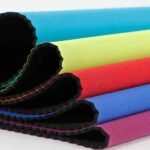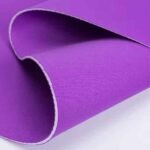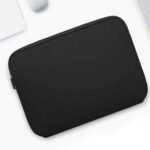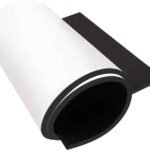Neoprene might not be the flashiest material out there, but it quietly powers some of the most essential items in our daily lives—from wetsuits to laptop sleeves and medical braces. Whether you’re catching waves or carrying your lunch, chances are neoprene is part of your life. So, what makes this synthetic rubber so versatile and indispensable across industries?
Neoprene is a flexible, waterproof, and durable synthetic rubber used in a wide range of products, including sportswear, medical supports, industrial equipment, and lifestyle accessories like bags and sleeves. Its insulation, elasticity, and resistance to water, weather, and wear make it ideal for both functional and fashionable use.
Let’s uncover how this unassuming material became the go-to choice for both global brands and practical consumers. Whether you’re a curious reader or a brand considering custom neoprene products, this guide will open your eyes to its potential.
What Is Neoprene and Why Is It So Popular?

Neoprene is a synthetic rubber known for its waterproof, flexible, and durable properties, making it popular in fashion, sports, medical, and industrial applications.
Dive Deeper: Understanding the Fundamentals
What Exactly Is Neoprene?
Neoprene, also known as polychloroprene, was developed by DuPont in 1930. It’s a synthetic rubber produced through the polymerization of chloroprene, offering superior resistance to water, chemicals, and temperature extremes.
Is Neoprene Waterproof?
Yes. Neoprene is inherently waterproof, making it an ideal material for aquatic gear like wetsuits, gloves, and waterproof bags. The closed-cell foam structure traps air and repels moisture.
What Are the Pros and Cons of Neoprene?
| Pros | Cons |
|---|---|
| Waterproof | Can trap heat (non-breathable) |
| Stretchy and flexible | Heavier than other fabrics |
| Durable and long-lasting | Not biodegradable |
| Chemical and UV resistant | Can cause irritation for sensitive skin |
Why Is Neoprene So Widely Used?
Neoprene’s versatility and cost-effectiveness make it an appealing option for manufacturers in various industries. Its ability to maintain shape and performance under stress is a huge bonus.
What Are the Most Common Uses of Neoprene in Daily Life?

Neoprene is commonly used in wetsuits, braces, gloves, bags, laptop sleeves, and insulation due to its durability, water resistance, and protective qualities.
Dive Deeper: Where You See Neoprene Every Day
Athletic and Sportswear
Neoprene is the material of choice for wetsuits, cycling shorts, and gym gloves due to its flexibility and thermal insulation. It keeps users warm in cold water while allowing mobility.
Fashion and Lifestyle Accessories
From trendy tote bags to sleek laptop sleeves, neoprene is a go-to for brands that want a modern, lightweight, and durable material.
What Does Neoprene Protect You From?
Neoprene acts as a barrier against cold, water, UV rays, wind, and minor impact. It’s also used to protect sensitive devices and body parts.
Medical and Orthopedic Products
Neoprene’s compressive qualities make it suitable for knee, elbow, and wrist braces. It supports muscles and joints while retaining heat to ease pain.
Home and Utility Applications
You’ll find neoprene in mouse pads, drink koozies, garden gloves, and even lunch bags. Its padding and insulating features provide everyday utility.
Which Industries Rely on Neoprene Products the Most?
Industries like sports, fashion, automotive, healthcare, and industrial manufacturing rely heavily on neoprene for its functional advantages.
Dive Deeper: Industry-Level Applications
Sports & Outdoor
Wetsuits, swim caps, life jackets, elbow/knee pads, and yoga mats are all neoprene-based. Brands trust neoprene for comfort and durability in active environments.
Fashion & Luxury
Neoprene is used in designer bags, modern jackets, and even shoes. Its form-fitting nature and sleek look offer a futuristic feel.
Healthcare Sector
Neoprene supports, braces, and orthopedic devices are widely used in clinics and therapy centers.
Automotive & Industrial
Used in seals, gaskets, hoses, and vibration dampeners, neoprene stands up to oil, heat, and heavy-duty wear.
Is Neoprene an Antifungal?
Yes, to an extent. Neoprene is naturally resistant to mildew and fungi, which makes it ideal for wet or humid environments.
How Is Neoprene Used in Custom Bag Manufacturing?

Neoprene is used in custom bags for its water resistance, cushioning, style, and versatility in shape and color.
Dive Deeper: From Fabric to Function
Why Brands Choose Neoprene for Bags
Neoprene offers a sleek, modern look while protecting contents. It’s lightweight, washable, and easy to cut into fashionable forms.
Common Custom Bag Styles
| Bag Type | Key Features |
|---|---|
| Neoprene Tote | Soft structure, roomy, machine washable |
| Laptop Sleeve | Shock absorption, snug fit, water resistant |
| Gym Bag | Lightweight, odor-resistant, easy to clean |
| Wine Carrier | Keeps temperature, impact-resistant |
How Szoneier Helps Brands Customize Neoprene Bags
At Szoneier, we offer:
- 100+ customizable styles
- Free design & sample service
- Logo printing (screen, heat transfer, embroidery)
- Small MOQ for new businesses
- 7-10 day rapid sampling
Our global clients include emerging lifestyle brands, outdoor gear startups, and promotional product companies.
Is Neoprene Safe for Skin?
Yes, neoprene is generally safe for skin, but prolonged contact may cause irritation for individuals with sensitivities or latex allergies.
Dive Deeper: Skin and Sensory Factors
Is Neoprene Hypoallergenic?
While neoprene itself is not a known allergen, additives used in manufacturing may cause reactions in sensitive users. Always check with your supplier.
Safe Usage Tips
- Use lined or coated neoprene for sensitive skin
- Avoid direct prolonged contact if irritation occurs
- Wash before first use
Common Use Cases
Neoprene is safely used in braces, gloves, swimsuits, and even baby products. When produced to medical-grade standards, it is considered skin-safe.
Do Neoprene Products Require Special Care or Maintenance?

Yes. Neoprene should be hand-washed in mild detergent and air-dried to maintain its elasticity and lifespan. Avoid direct sunlight and machine washing.
Dive Deeper: Caring for Your Neoprene Items
Cleaning Best Practices
- Hand wash with lukewarm water and mild soap
- Rinse thoroughly to remove all residue
- Hang dry in a shaded area
Storage Tips
- Avoid folding to prevent creasing
- Store in cool, dry areas
- Keep away from sharp objects
Common Mistakes to Avoid
- Using bleach or harsh chemicals
- Ironing neoprene fabric
- Storing in damp places (encourages odor or mildew)
Are There Any Limitations or Drawbacks to Using Neoprene?

Yes. While neoprene is durable and versatile, it has limitations like lack of breathability, non-biodegradability, and higher cost compared to basic fabrics.
Dive Deeper: Know Before You Choose
Environmental Considerations
Neoprene is a petroleum-based synthetic material. Although durable, it’s not biodegradable. Some eco-alternatives like limestone neoprene are emerging.
Cost and Sourcing
Neoprene is pricier than nylon or polyester but offers better performance and aesthetics. Bulk orders and factory-direct sourcing (like Szoneier) can reduce costs.
Performance Limits
- Not ideal for high-heat environments
- Traps body heat (can be uncomfortable in hot climates)
- May lose flexibility over many years of use
Summary: Pros and Cons Revisited
Refer back to the table in Section 1 for a complete view before making your material choice.
Ready to Create Your Custom Neoprene Product?
At Szoneier, we specialize in crafting high-quality, custom neoprene products for brand owners, wholesalers, and retailers worldwide. Whether you need stylish tote bags, protective laptop sleeves, or promotional items made from neoprene, we offer:
- Free design services
- Free samples
- Small MOQs
- Fast production and shipping
- Full logo customization options
Contact us today to get started with your custom neoprene bag project. Let’s turn your brand vision into a functional, stylish product your customers will love.











